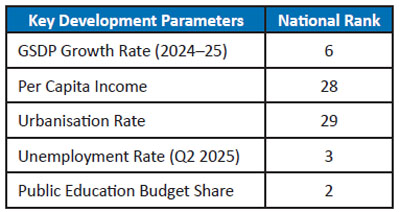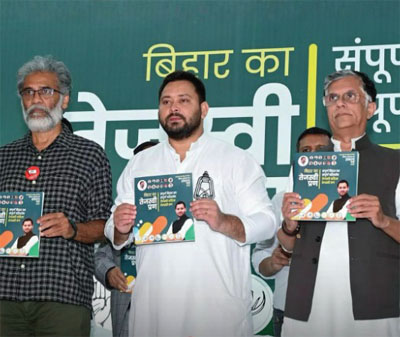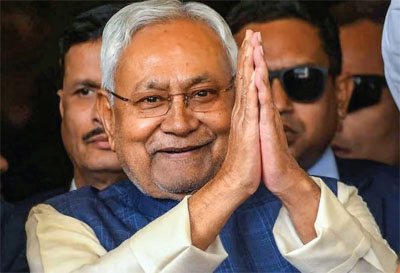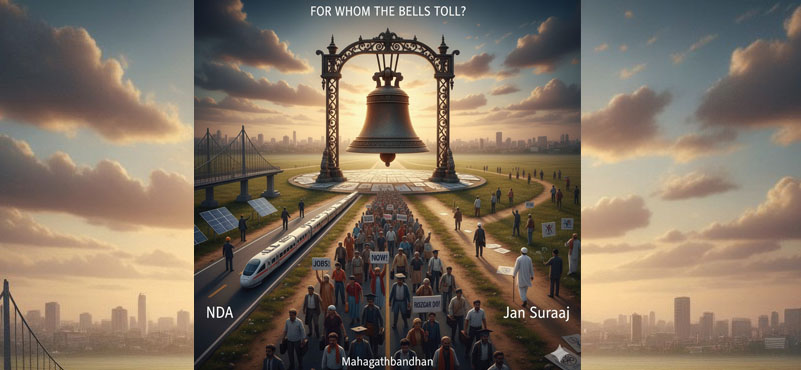Early this month, Bihar will head for a legislative assembly election. All Bihar elections are high-stakes and attract media eyeballs and national attention. But the stakes are much higher this time and the reverberations of the poll’s outcome will be felt in Delhi as much as in Bihar.
A Major Political Shift?
On 2nd October 2022, as India celebrated the birth anniversary of two of its greatest sons, Lal Bahadur Shastri and Mahatma Gandhi, poll strategist and consultant Prashant Kishor quietly embarked on a 3,500-kilometer padyatra (foot march) in Bihar. Not many took him seriously then. After all, Bihar is a tough nut to crack. Caste calculus and traditional vote banks are deeply embedded in the state’s politics, often leaving even the most seasoned political commentators and psephologists clueless about electoral outcomes. After a whirlwind two-year tour of the state’s hinterland, Prashant Kishor (PK) formed the Jan Suraaj Party on 2nd of October 2024, in a deeply symbolic move, taking a leaf out of Mahatma Gandhi’s playbook by using people to power political campaigns.
Since the dawn of the Karpoori Thakur-style socialism, which relegated the once-towering Congress to a minnow, Bihar has witnessed two political poles. One led by the Rashtriya Janata Dal (RJD), backed by a solid Muslim-Yadav vote bank. The second led by the BJP and smaller parties. To the BJP’s credit, it has been able to shed its image of being a predominantly Baniya-Brahmin party to widen its social acceptance, thanks to the deft political maneuvering by Amit Shah and the unquestionable appeal of PM Modi. The BJP has been able to attract useful allies like Lok Janshakti Party (Ramvilas) and Hindustani Awam Morcha (HAM) that have influence over small yet crucial vote banks. Together, they have been able to arrest Tejashwi’s dream of leading Bihar, keeping the RJD away from power while stitching a powerful coalition.
PK: King, Kingmaker or Neither?
With the rise of the Jan Suraaj Party, many, especially youth and those tired with the same political faces and formations, seem to believe that Bihar now has a viable third front. PK has stayed on course, focusing his campaign on good governance and education, questioning the state’s inability to stem migration, which remains a touchy subject for a large majority of people. As Biharis work across the country, they have witnessed how other states have transformed over the years and yearn for a similar script at home.
 They are questioning the lack of jobs, industry, and opportunities for quality education, as other BIMARU states (an acronym of least developed states of Bihar, Madhya Pradesh, Rajasthan and Uttar Pradesh, coined by economist Ashish Bose in the 1980s) have galloped ahead, leaving Bihar alone in what is a shameful categorization. Uttar Pradesh, a close neighbour once sharing Bihar’s shame, lawlessness and lack of economic opportunities, has transformed into a growth engine of the country in the past decade, creating further angst and hunger for change. PK’s focus on migration, education and economy seems to have touched a raw nerve, at least that is what media reports suggest.
They are questioning the lack of jobs, industry, and opportunities for quality education, as other BIMARU states (an acronym of least developed states of Bihar, Madhya Pradesh, Rajasthan and Uttar Pradesh, coined by economist Ashish Bose in the 1980s) have galloped ahead, leaving Bihar alone in what is a shameful categorization. Uttar Pradesh, a close neighbour once sharing Bihar’s shame, lawlessness and lack of economic opportunities, has transformed into a growth engine of the country in the past decade, creating further angst and hunger for change. PK’s focus on migration, education and economy seems to have touched a raw nerve, at least that is what media reports suggest.
PK’s party has smartly fielded a new breed of candidates who are free from corruption or criminal charges, and are intellectuals or professionals. Some are even calling him the Kejriwal of Bihar. He would surely avoid and detest such a comparison.
Whether PK’s efforts convert into votes and seats for the Jan Suraaj is anybody’s guess. Only the results will tell whether PK becomes a king or a kingmaker, or neither. But his party and disproportionate media attention has surely caught the attention of the principal players. His decision to not contest the elections has shocked many, as he was expected to lead the fight from one of the prestigious seats, even taking on someone like a Samrat Choudhary or Tejashwi Yadav.
BJP’s counter-maneuvers: Visible, Hard Infrastructure and Cash Transfer
The BJP-led NDA has not been oblivious to the challenges of a tiring Nitish and years of anti-incumbency. The BJP has accorded important portfolios to turncoats with serious criminal charges, most notably the deputy chief minister position to Samrat Choudhary. His father, Ashok Choudhary, has the dubious distinction of serving as a cabinet minister in state governments headed by RJD, JD(U) and, briefly, HAM.
That aside, the central government has opened its coffers for Bihar. Remember the Union Budget of 2024 – the central government allocated 59,000 crores (26,000 crores for world-class expressways, 21,400 crores for a 2,400 MW super-critical power plant and 11,500 crores for flood management projects). Visible, hard infrastructure is propping up across the state. A new and swanky airport terminal has replaced a glorified bus stand-like old terminal in Patna. A new airport in Darbhanga is attracting new airlines, due to high load factors, and Purnia too is now connected by flights, increasing the number of airports to 5 from a measly 3. Patna is soon going to be connected with direct flights to Sharjah, Colombo, Kathmandu and Singapore, boosting international connectivity, trade and commerce. This should also enable some tourism, which has never really taken off despite amazing prospects.
An All India Institute of Medical Sciences (AIIMS) is under construction in Darbhanga, which is likely to help ease the pressure on AIIMS Patna. Some other projects, such as New Software Technology Parks of India (STPI), have been inaugurated in Darbhanga and Patna.
The focus has equally been on revadi politics (freebies) and direct bank transfers to voters, which some may say is a bribe for votes. Over 25 lakh Bihari women were handed out 10,000 rupees each under the Mukhya Mantri Mahila Rojgar Yojna by CM Nitish Kumar for self-employment in what is now a national phenomenon of throwing open the state coffers before polls. Women voters have favored Nitish Kumar due to his liquor ban policy. However, how will the state’s exchequer foot the bill without any serious sources of revenue is a moot question. Perhaps such questions can be discussed after the elections. Now is not the time for caution! Despite these efforts, systemic challenges remain. And PK has left no stone unturned in exposing them.
 NDA’s Poll Plank: Management From the Very Top
NDA’s Poll Plank: Management From the Very Top
For BJP, all elections are crucial – such is its leadership’s style of functioning. Bihar is all the more. De facto number two of the party, Amit Shah camped in Patna before Diwali to iron out the seat-sharing formula, even individually meeting rebels and disgruntled leaders – some of whom had switched sides, opting for Prashant Kishor’s Jan Suraaj. His outreach seems to have worked. Most disgruntled leaders have returned to the camp, embracing BJP’s decision around candidates, forcing Prashant Kishor to allege that the BJP is using all the tricks in the playbook to derail Jan Suraaj’s poll preparations. Amit Shah’s personal touch has given the NDA a crucial advantage of a united front where there are no friendly fights and negligible chances of internal sabotage.
The NDA has opted for an Umbrella coalition, with Nitish Kumar as the declared chief minister. The BJP is backed by a solid upper caste vote base, as evidenced by the ticket distribution. The party has fielded 49 upper caste candidates who comprise approximately 12% of the state’s population. The party is contesting on 101 seats in 32 districts out of the total 243 seats across 38 districts. JD(U) too is fielding equal number of candidates, leaving 29 seats for Chirag Paswan’s LJP (Ramvilas) and 6 each for Upendra Kushwaha’s RLM and former CM Jeetan Ram Manjhi’s HAM.
The BJP’s poll plank rests on evoking the painful memories of Lalu Yadav’s Jungleraaj, while wooing electorates with the promise of a double-engine sarkar, led by Nitish Kumar in Bihar and Narendra Modi in Delhi. The state government has been showcasing its achievements. CM Nitish Kumar was quick to inaugurate the phase 1 of Patna metro even though the operational line is only 3.45 kilometers.
The JD(U) Dilemma: Why Bihar Matters for Mahagathbandhan and the BJP
 Bihar’s longest-reigning Chief Minister, Nitish Kumar will, in all likelihood, fight his last elections. While any observer would not risk writing his political obituary, growing murmurs about his age and limited political options do indicate that this election will be his swansong. A wily politician, Nitish has proven his detractors wrong on several occasions and his party cadres would hope the same. All depends on the number game. If BJP is able to firmly establish itself as the senior partner, it would want to install its own chief minister. However, it will have to placate Nitish Kumar who is known for hard bargains. That he is key to BJP’s power at the center (JD (U) accounts for 16 Members of Parliament) means that Nitish will be dealt with deftly, unlike some other BJP allies across India that faced unceremonious exit.
Bihar’s longest-reigning Chief Minister, Nitish Kumar will, in all likelihood, fight his last elections. While any observer would not risk writing his political obituary, growing murmurs about his age and limited political options do indicate that this election will be his swansong. A wily politician, Nitish has proven his detractors wrong on several occasions and his party cadres would hope the same. All depends on the number game. If BJP is able to firmly establish itself as the senior partner, it would want to install its own chief minister. However, it will have to placate Nitish Kumar who is known for hard bargains. That he is key to BJP’s power at the center (JD (U) accounts for 16 Members of Parliament) means that Nitish will be dealt with deftly, unlike some other BJP allies across India that faced unceremonious exit.
Bihar is a crucial piece of the Hindi heartland puzzle. Winning Bihar emphatically will strengthen PM Modi’s stature, reaffirming his hold on the Indian electorate. A grand victory will also dampen whatever remains of Opposition unity, turbocharging BJP cadres to prepare for the all-important elections in West Bengal in 2026 and later, Uttar Pradesh in 2027. Despite valiant efforts, BJP has not been able to breach Mamata Banerjee’s fortress. A win in Bihar may be the right impetus for the BJP’s rank and file.
On the other hand, losing Bihar may create perception issues, as the coalition government at the centre relies heavily on regional satraps, most notably Nitish Kumar’s JD(U), to maintain a comfortable majority. A loss in Bihar will embolden the Opposition, potentially attracting new allies and creating new battlefronts for BJP to contend with.
RJD: The Principal Challenger Leading the Mahagathbandhan
 Unlike the NDA, discord in seat sharing, a conspicuous absence of Rahul Gandhi, multiple friendly fights on key seats and an unravelling family drama in the Lalu family have created serious perception challenges for the Tejashwi-led Mahagathbandhan. The grand alliance comprises RJD, Congress, the Communist Party of India (CPI) and other smaller parties such as the Vikassheel Insaan Party (VIP), led by Mukesh Sahni – also the alliance’s deputy CM face. The RJD is contesting on 143 seats out of 243, one less than in 2020, while Congress is staking claim on 48 seats. The rest are being shared among other alliance partners.
Unlike the NDA, discord in seat sharing, a conspicuous absence of Rahul Gandhi, multiple friendly fights on key seats and an unravelling family drama in the Lalu family have created serious perception challenges for the Tejashwi-led Mahagathbandhan. The grand alliance comprises RJD, Congress, the Communist Party of India (CPI) and other smaller parties such as the Vikassheel Insaan Party (VIP), led by Mukesh Sahni – also the alliance’s deputy CM face. The RJD is contesting on 143 seats out of 243, one less than in 2020, while Congress is staking claim on 48 seats. The rest are being shared among other alliance partners.
All Is Not Well
The Congress, buoyed by Rahul Gandhi’s Voter Yatra, was expecting more seats in the grand alliance. However, the lack of agreement on seat sharing between Congress and RJD has led to a confusing situation on the ground, where several Congress and RJD heavyweights are pitted against each other. For instance, Congress’ Aditya Kumar Raja is taking on Shivani Shukla in Lalganj Assembly segment of Vaishali district, while several other seats are witnessing a similar pandemonium. Such discord and PK’s sway may cumulatively eat into Mahagathbandhan’s fortunes. Rahul Gandhi is yet to hit the ground running, while PM Modi has already started his poll blitz, creating serious concerns in the Congress’s cadres.
Tejashwi, too, has promised the moon and back to the voters, trying to one-up the BJP in cash incentives. In what seems to be a bizarre promise, even by Indian politicians’ standards, he has promised to give a government job to all families in Bihar. He has also raked up the Waqf Board issue, promising to relegate the bill into the dustbin if the grand alliance wins, in a bid to woo the Muslim vote that is now seeking greater representation (a deputy CM seat) other than political patronage against the alleged atrocities of the BJP.
Will the Women Voter Hold the Key? Different Voices on Liquor Ban
Across states, women voters have increasingly impacted electoral outcomes. From giving a thumping win to the Maha Yuti coalition in Maharashtra to powering BJP’s victory in Madhya Pradesh, women voters have come to their own. All political parties are trying to outdo one another to woo women voters in Bihar. Aside from law and order and other such women-related issues, the question of liquor ban has also come to the fore.
 Interestingly, PK has promised to do away with the ban, citing increasing cases of smuggling and the mafia-politician nexus that benefits from such bans. Does PK know better than others to go against the tide? His decision to revoke the liquor ban “within an hour” of coming to power may either be good economics or perhaps he has a better pulse of the electorate than the rest. PK’s political outreach is based on surveys and constant public feedback. He may be echoing broader public sentiment. Liquor ban is also a huge drain on the exchequer for a revenue-starved state. Given a spate of welfare and direct cash transfer schemes, it could be a good way to offset expenditure and create a source of income.
Interestingly, PK has promised to do away with the ban, citing increasing cases of smuggling and the mafia-politician nexus that benefits from such bans. Does PK know better than others to go against the tide? His decision to revoke the liquor ban “within an hour” of coming to power may either be good economics or perhaps he has a better pulse of the electorate than the rest. PK’s political outreach is based on surveys and constant public feedback. He may be echoing broader public sentiment. Liquor ban is also a huge drain on the exchequer for a revenue-starved state. Given a spate of welfare and direct cash transfer schemes, it could be a good way to offset expenditure and create a source of income.
The BJP has toed the JD(U) line while the RJD has given mixed signals, suggesting that local liquor (toddy) could be removed from the purview of the ban, eyeing the Pasi community vote bank. Though they constitute less than one percent of the population, they remain a crucial vote bank due to a highly competitive electoral landscape and a history of close contests on several seats.
Who will the women vote for may overwhelmingly shape the fortunes of the alliances. They remain quiet and observant, as do the rest. They will speak soon. Bihar awaits. India awaits.








